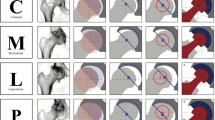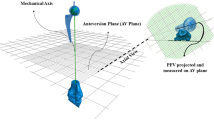Abstract
Purpose
Concurrent use of minus heads with tapered stems in total hip arthroplasty (THA) decreases the prosthetic range of motion (pROM). Three-dimensional preoperative templating can simulate the location of the impingement by taking the hip through a virtual pROM. This enables surgeons to simulate how modifying the type of implant, orientation, and position influences impingement. We hypothesized that CT-based modeling would result in a decrease in the pROM, thereby increasing the risk of impingement when minus heads are used.
Methods
Forty-three patients who underwent robotic-assisted primary THAs were included. Prosthetic head diameter (32/36-mm) and head length (minus/zero/plus) were the predictors. Maximum external rotation at full hip extension and internal rotation at 90° and 100° of flexion prior to prosthetic impingement were the outcome variables. A CT-based preoperative planning software was used for pROM estimation and impingement detection.
Results
Significant decreases in pROM were found for both head diameters as the head length decreased and was more pronounced in external rotation during full hip extension (changes of 2.8–3.4° for the 32-mm head and 1.6–2.8° for the 36-mm head (p = 0.00011)). The magnitude of loss in pROM when using a minus head was larger than the gain provided by a plus head in tapered stems (p < 0.0001).
Conclusion
Head length affects the offset and pROM. When the use of minus heads or smaller heads is indicated, 3D preoperative templating for assessing postoperative pROM and impingement provides surgeons with options to consider alternate surgical plans offering additional assurance and protection from dislocation.



Similar content being viewed by others
References
Grammatopoulos G, Gofton W, Jibri Z et al (2019) 2018 Frank Stinchfield award: spinopelvic hypermobility is associated with an inferior outcome after THA: examining the effect of spinal arthrodesis. Clin Orthop Relat Res 477(2):310–321. https://doi.org/10.1097/CORR.0000000000000367
Eftekhar NS (1976) Dislocation and instability complicating low friction arthroplasty of the hip joint. Clin Orthop Relat Res 121:120–125
Eftekhary N, Shimmin A, Lazennec JY et al (2019) A systematic approach to the hip-spine relationship and its applications to total hip arthroplasty. Bone Joint J 101-B(7):808–816. https://doi.org/10.1302/0301-620X.101B7.BJJ-2018-1188.R1
Lazennec JY, Charlot N, Gorin M et al (2004) Hip-spine relationship: a radio-anatomical study for optimization in acetabular cup positioning. Surg Radiol Anat 26(2):136–144. https://doi.org/10.1007/s00276-003-0195-x
Woo RY, Morrey BF (1982) Dislocations after total hip arthroplasty. J Bone Joint Surg Am 64(9):1295–1306
Sculco PK, Austin MS, Lavernia CJ, Rosenberg AG, Sierra RJ (2016) Preventing leg length discrepancy and instability after total hip arthroplasty. Instr Course Lect 65:225–241
Brooks PJ (2013) Dislocation following total hip replacement: causes and cures. Bone Joint J 95-B(11 Suppl A):67–69. https://doi.org/10.1302/0301-620X.95B11.32645
Morrey BF (1997) Difficult complications after hip joint replacement. Dislocation Clin Orthop Relat Res 344:179–187
Mahoney CR, Pellicci PM (2003) Complications in primary total hip arthroplasty: avoidance and management of dislocations. Instr Course Lect 52:247–255
Higgins BT, Barlow DR, Heagerty NE, Lin TJ (2015) Anterior vs. posterior approach for total hip arthroplasty, a systematic review and meta-analysis. J Arthroplasty 30(3):419–434. https://doi.org/10.1016/j.arth.2014.10.020
Barrack RL (2003) Dislocation after total hip arthroplasty: implant design and orientation. J Am Acad Orthop Surg 11(2):89–99. https://doi.org/10.5435/00124635-200303000-00003
Barrack RL, Butler RA, Laster DR, Andrews P (2001) Stem design and dislocation after revision total hip arthroplasty: clinical results and computer modeling. J Arthroplasty 16(8 Suppl 1):8–12. https://doi.org/10.1054/arth.2001.28359
Scifert CF, Brown TD, Pedersen DR, Callaghan JJ (1998) A finite element analysis of factors influencing total hip dislocation. Clin Orthop Relat Res 355:152–162. https://doi.org/10.1097/00003086-199810000-00016
Allen CL, Hooper GJ, Frampton CMA (2014) Do larger femoral heads improve the functional outcome in total hip arthroplasty? J Arthroplasty 29(2):401–404. https://doi.org/10.1016/j.arth.2013.06.017
Lombardi AV, Skeels MD, Berend KR, Adams JB, Franchi OJ (2011) Do large heads enhance stability and restore native anatomy in primary total hip arthroplasty? Clin Orthop Relat Res 469(6):1547–1553. https://doi.org/10.1007/s11999-010-1605-0
Berry DJ, von Knoch M, Schleck CD, Harmsen WS (2005) Effect of femoral head diameter and operative approach on risk of dislocation after primary total hip arthroplasty. J Bone Joint Surg Am 87(11):2456–2463. https://doi.org/10.2106/JBJS.D.02860
Shoji T, Ota Y, Saka H et al (2020) Factors affecting impingement and dislocation after total hip arthroplasty - computer simulation analysis. Clin Biomech (Bristol, Avon) 80:105151. https://doi.org/10.1016/j.clinbiomech.2020.105151
Cho MR, Choi WK, Kim JJ (2016) Current concepts of using large femoral heads in total hip arthroplasty. Hip Pelvis 28(3):134–141. https://doi.org/10.5371/hp.2016.28.3.134
Chandler DR, Glousman R, Hull D et al (1982) Prosthetic hip range of motion and impingement. The effects of head and neck geometry. Clin Orthop Relat Res 166:284–291
Shah SM (2019) Survival and outcomes of different head sizes in primary total hip arthroplasty. J Orthop 16(6):A1–A3. https://doi.org/10.1016/j.jor.2019.10.001
Salmons HI, Karczewski D, Ledford CK, Bedard NA, Wyles CC, Abdel MP (2023) Femoral head length impact on outcomes following total hip arthroplasty in 36 millimeter cobalt chrome-on-highly crosslinked polyethylene articulations. J Arthroplasty 38(9):1787–1792. https://doi.org/10.1016/j.arth.2023.02.031
Tung WS, Donnelley C, Pour AE, Tommasini S, Wiznia D (2023) Simulating movements of daily living in robot-assisted total hip arthroplasty with 3D modelling. Bone Jt Open 4(6):416–423. https://doi.org/10.1302/2633-1462.46.BJO-2023-0046.R1
Faul F, Erdfelder E, Buchner A, Lang AG (2009) Statistical power analyses using G*Power 3.1: tests for correlation and regression analyses. Behav Res Methods 41(4):1149–1160. https://doi.org/10.3758/BRM.41.4.1149
Tsikandylakis G, Mohaddes M, Cnudde P, Eskelinen A, Kärrholm J, Rolfson O (2018) Head size in primary total hip arthroplasty. EFORT Open Rev 3(5):225–231. https://doi.org/10.1302/2058-5241.3.170061
Vigdorchik JM, Sharma AK, Madurawe CS, Elbuluk AM, Baré JV, Pierrepont JW (2020) Does prosthetic or bony impingement occur more often in total hip arthroplasty: a dynamic preoperative analysis. J Arthroplasty 35(9):2501–2506. https://doi.org/10.1016/j.arth.2020.05.009
Kobayashi H, Nakashima Y, Yamamoto T et al (2016) Late anterior dislocation due to posterior pelvic tilt in total hip arthroplasty. Open Orthop J 10:206–212. https://doi.org/10.2174/1874325001610010206
Sato T, Nakashima Y, Matsushita A, Fujii M, Iwamoto Y (2013) Effects of posterior pelvic tilt on anterior instability in total hip arthroplasty: a parametric experimental modeling evaluation. Clin Biomech (Bristol, Avon) 28(2):178–181. https://doi.org/10.1016/j.clinbiomech.2012.12.011
Funding
1. Aidin Eslam Pour, MD, MS, FAAOS received funding from:
Agency: National Institute of Arthritis, Musculoskeletal and Skin Diseases.
I.D.#: 5 K08 AR073933
Agency: Orthopaedic Research and Education Foundation.
I.D.#: 22–071
Author information
Authors and Affiliations
Contributions
All authors contributed to the study conception and design. Material preparation, data collection and analysis were performed by [Aidin Eslam Pour and Wei Shao Tung and Claire A Donnelley]. The first draft of the manuscript was written by [Aidin Eslam Pour and Wei Shao Tung and Claire A Donnelley] and all authors commented on previous versions of the manuscript. All authors read and approved the final manuscript.
Corresponding author
Ethics declarations
Ethics approval
This retrospective study was performed in line with the principles of the Declaration of Helsinki. Approval was granted by the Ethics Committee of Yale University and study was found exempt (Date: 2/22/2022 /No: 2000032304).
Consent to participate
Consent to participate was not found necessary to obtain for this retrospective chart/imaging review study.
Consent to publish
Consent to publish was not found necessary to obtain for this retrospective chart/imaging review study.
Competing interests
The authors have no relevant financial or non-financial interests to disclose.
Additional information
Publisher's Note
Springer Nature remains neutral with regard to jurisdictional claims in published maps and institutional affiliations.
Rights and permissions
Springer Nature or its licensor (e.g. a society or other partner) holds exclusive rights to this article under a publishing agreement with the author(s) or other rightsholder(s); author self-archiving of the accepted manuscript version of this article is solely governed by the terms of such publishing agreement and applicable law.
About this article
Cite this article
Eslam Pour, A., Tung, W.S., Donnelley, C.A. et al. Using preoperative planning software to assess the effect of head length on prosthetic range of motion in a high-risk population: a three-dimensional modeling study. International Orthopaedics (SICOT) (2024). https://doi.org/10.1007/s00264-024-06191-8
Received:
Accepted:
Published:
DOI: https://doi.org/10.1007/s00264-024-06191-8




